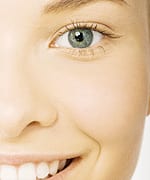Life Extension Magazine®
Of the five human senses, vision is perhaps the most precious of all, as it allows us to see and navigate the world around us. With each passing year, however, adults become more likely to develop vision-robbing conditions such as macular degeneration and cataracts. While cataracts may be treated surgically, macular degeneration can lead to permanent blindness. Fortunately, zeaxanthin, lutein, and meso-zeaxanthin offer much-needed structural support for the aging macula. Derived from colorful fruits and vegetables, lutein and zeaxanthin protect delicate eye tissues from the dangers of oxidative stress and high-energy blue light. Unlike lutein and zeaxanthin, meso-zeaxanthin is not found in the diet, but is usually converted in the retina from ingested lutein.1 Zeaxanthin, lutein, and meso-zeaxanthin exert broad-spectrum effects, not only helping to protect the eyes, but also providing essential support for the skin and the cardiovascular system. Xanthophylls: Nature’s Own SunscreenLike the well-known nutrients beta-carotene and lycopene, zeaxanthin and lutein are carotenoids, brightly colored pigments that occur naturally in a variety of plants, particularly fruits and vegetables. Technically, zeaxanthin and lutein belong to a class of carotenoids known as xanthophylls, which are found in variously hued fruits and vegetables, predominantly in those colored yellow, orange, and green. Xanthophylls serve as natural sunscreens in plants, protecting them from the damaging effects of excessive light-derived energy. Rich food sources of zeaxanthin include orange peppers, sweet yellow corn, honeydew, mangoes, oranges, and peaches. Lutein is found in dark green leafy vegetables, broccoli, asparagus, sweet yellow corn, squash, kiwi, pumpkin, and peas.2 Egg yolks are also loaded with zeaxanthin and lutein, probably even more so than fruits and vegetables.2 Some scientists now believe that eating an egg a day may help confer some of the beneficial effects of these carotenoids, while not adversely affecting serum cholesterol.3 Lutein is far more prevalent than zeaxanthin in both the human body and diet, though zeaxanthin appears to be a more chemically potent antioxidant.4 While short-term dietary deficiencies of zeaxanthin and lutein have not been shown to cause disease directly, scientists believe these carotenoids may be what are known as conditionally essential nutrients—that is, nutrients that, when present in optimal amounts, may offer important disease-preventive effects.5 Long-term depletion of zeaxanthin and lutein is associated with eye diseases, aging skin, and atherosclerosis, as well at least one type of cancer (bladder cancer).5-8 This may be due to a diminished ability to defend against free-radical assault in certain body tissues—most notably, the eyes.5
Scientists have repeatedly demonstrated the protective effects of zeaxanthin, lutein, and meso-zeaxanthin on the eyes. High concentrations of these carotenoids are found in the macula, a specialized area of the eye’s retina that is responsible for detailed vision due to its high concentration of light-detecting cone cells. The macula appears as a yellow spot in the retina, due to the presence of zeaxanthin, lutein, and meso-zeaxanthin.9 Accordingly, these carotenoids are commonly referred to as macular pigments. Although other carotenoids can be found in the foods we eat, only zeaxanthin and lutein accumulate in the macula. If taken as a supplement, meso-zeaxanthin is absorbed into the bloodstream and effectively increases macular pigment levels.10 These carotenoids protect the retina by absorbing harmful ultraviolet rays and blue-green light, which can eventually damage the retina and lead to vision loss.9 They can thus be thought of as natural sunscreens for the eyes. The eye lens is also rich in both zeaxanthin and lutein.9 The lens focuses light entering the eye on the eye’s retina. Optimal health of the eye lens is essential for protecting against cataracts. Guarding Against Macular DegenerationAge-related macular degeneration causes the irreversible death of photoreceptors (light sensors) in the eyes, and presently has no cure. It is the most common cause of vision loss in the elderly, and its prevalence is expected to rise as the population continues to age. More than 17 million Americans have signs or symptoms of the disease, and more than 2 million are functionally blind. Advanced disease is seen in 7% of adults over the age of 75, and early or intermediate disease is found in 25% of those over 65. Effective strategies for minimizing or slowing the progression of macular degeneration are desperately needed, as this disease causes significant disability and diminished quality of life. In addition, macular degeneration is strongly linked to both cardiovascular and cerebrovascular disease.11 The major risk factor for age-related macular degeneration is the loss or decreased density of macular pigment.12 Smoking is an additional risk factor, due to its detrimental effect on macular pigment. In macular degeneration, abnormal deposits called drusen develop in the retina and macula, damaging this cellular layer. A subtype of the disease, called wet macular degeneration, additionally involves the formation of abnormal blood vessels that grow beneath the retina. Dietary modifications have emerged as a safe, cost-effective strategy that may delay the onset and slow the progression of age-related macular degeneration. Scientists have been studying the effects of antioxidant nutrients on age-related macular degeneration for nearly 20 years.13 In 1994, the Eye Disease Case Control Study showed that an increase in dietary carotenoids—particularly zeaxanthin and lutein—decreased the risk of developing wet macular degeneration.4 A milestone in developing treatments for macular degeneration was the Lutein Antioxidant Supplementation Trial (LAST) of 2004, which showed that supplementing with lutein and other nutrients improved the signs and symptoms of the disease. After supplementing with lutein and other nutrients for one year, the trial subjects demonstrated improved macular pigment density, as well as improvements in various aspects of visual function, including contrast sensitivity and visual acuity.14 The recent Carotenoids in Age-Related Eye Disease Study (CAREDS) of 2006—an offshoot of the Women’s Health Initiative—noted a correlation between age-related macular degeneration and women’s dietary intake of zeaxanthin and lutein. This trial examined nearly 1,800 women, aged 50-79, who had a high or low intake of zeaxanthin or lutein at the onset of the Women’s Health Initiative. In subjects under the age of 75, those with higher intakes of lutein plus zeaxanthin (3 mg or more daily) had a 43% lower risk for intermediate age-related macular degeneration compared to those who consumed just 0.75 mg or less of lutein and zeaxanthin daily.15 Now under way, the CAREDS II trial will examine the effects of zeaxanthin, lutein, and omega-3 fatty acid intake on the progression and other aspects of age-related macular degeneration. Long-term prospective and clinical double-blind and placebo-controlled studies are needed to further elucidate the relationship between carotenoids and age-related macular degeneration.15
Vital Protection Against CataractsIn addition to preventing and slowing the progression of age-related macular degeneration, zeaxanthin and lutein may protect against the development and clinical progression of cataracts. Cataracts occur as the lenses of the eyes gradually and painlessly become opaque, leading to impaired vision. A large proportion of elderly Americans exhibit some sign of cataracts. The Nurses Health Study examined the impact of 12 years of carotenoid consumption on cataract formation in more than 77,000 female nurses over the age of 45. After controlling for factors such as age and smoking, women with the highest intake of zeaxanthin and lutein had a 22% lower risk of cataract extraction (defined as cataracts severe enough to require surgical removal). More frequent intake of spinach and kale—two foods rich in lutein—was also linked to a moderately lower risk of cataract.18
Another study examined the effects of lutein and vitamin E on visual function in adults with age-related cataracts. Seventeen patients with clinically diagnosed cataracts participated in this randomized, placebo-controlled study. They supplemented with 15 mg of lutein, 100 mg of vitamin E (as alpha-tocopherol), or a placebo, three times a week for up to two years. Visual performance and serum levels of lutein and vitamin E were measured every three months. Those who supplemented with lutein demonstrated improvements in visual performance, including visual acuity and glare sensitivity. By contrast, visual function was merely maintained in the vitamin E group, while actually deteriorating in the placebo group. Higher intake of lutein may thus help improve visual function in adults with age-related cataracts.19 Despite findings suggesting that abundant intake of lutein, zeaxanthin, and meso-zeaxanthin can help reduce the risks of these two primary sight-robbing diseases,9 the FDA has not approved qualified health claims that these nutrients can help prevent age-related macular degeneration or cataracts. More comprehensive studies will be needed in order to secure this approval.20 Benefits for Skin HealthThe health benefits of zeaxanthin and lutein are not limited to the eyes. Just as these carotenoids protect the eye’s macula and lens, they may similarly protect the skin against detrimental age-related changes, such as reduced flexibility, hydration, and lipid content. In a placebo-controlled study titled “Clinical Evidence for Lutein and Zeaxanthin in Skin Health,” a combination of orally consumed and topically administered lutein produced numerous benefits for the skin. These included improvements in skin hydration, skin elasticity, and concentration of superficial skin lipids. Lipid oxidation, which leads to skin aging, was also decreased. These skin health benefits were greatest in subjects who both consumed oral lutein supplements and applied a topical lutein formulation. Notably, it was lutein supplements—rather than intake of lutein from food sources—that led to improvements in the skin’s youthfulness.6
Evidence of Cardiovascular ProtectionZeaxanthin and lutein may also help prevent atherosclerosis, a primary contributor to heart attacks, strokes, and peripheral vascular disease. In the 18-month Los Angeles Atherosclerosis Study, scientists tracked 573 middle-aged men and women who were free of symptomatic cardiovascular disease. Subjects with higher baseline blood levels of zeaxanthin and lutein demonstrated a decrease in carotid intima-media thickness at the study’s completion. Since increased carotid intima-media thickness signifies the progression of atherosclerotic disease, these findings suggest that zeaxanthin and lutein helped protect against early atherosclerosis.8 Researchers speculate that the antioxidant effects of zeaxanthin and lutein are likely responsible for their cardioprotective effects. Dosage, Absorption, and SafetyEpidemiological studies indicate that humans need to consume approximately 6-20 mg of lutein and zeaxanthin daily to realize their beneficial health effects.4 While diets rich in fruits, vegetables, and egg yolk can increase levels of zeaxanthin and lutein, it may be difficult to achieve optimal amounts through dietary sources alone. Meso-zeaxanthin, which makes up 25% of the structural density of the macular pigment, is virtually absent from all diets. Supplementing with zeaxanthin, lutein, and meso-zeaxanthin may be the best way to ensure that you are ingesting optimal amounts of these critical nutrients. Zeaxanthin and lutein are fat soluble, and may be best absorbed when consumed with a source of dietary fats. Certain cholesterol-lowering medications, including cholestyramine (Questran®) and colestipol (Colestid®) may reduce the absorption of fat-soluble carotenoids. Mineral oil, corn oil, and olestra may also inhibit the absorption of zeaxanthin and lutein.21 Zeaxanthin and lutein are considered safe and well tolerated, with no adverse effects or toxicities reported at doses of up to 40 mg daily for two months. Since studies in pregnant women and nursing mothers have not yet been conducted, these women should obtain zeaxanthin and lutein through dietary sources until more information is available.21
ConclusionFor most adults, a life without the gift of vision is simply unimaginable. Yet like so many age-related afflictions, vision problems like cataracts and age-related macular degeneration are commonly accepted as an inevitable consequence of growing older. Fortunately, a proactive nutritional strategy that incorporates abundant intake of the carotenoid antioxidants zeaxanthin, lutein, and meso-zeaxanthin can provide targeted protection for your eyes, while conferring additional health benefits for the skin and heart. | |||||||
| References | |||||||
| 1. Bone RA, Landrum JT, Hime GW, et al. Stereochemistry of the human macular carotenoids. Invest Ophthalmol Vis Sci. 1993 May; 34(6):2033-40. 2. Sommerburg O, Keunen JE, Bird AC, van Kuijk FJ. Fruits and vegetables that are sources for lutein and zeaxanthin: the macular pigment in human eyes. Br J Ophthalmol. 1998 Aug;82(8):907-10. 3. Goodrow EF, Wilson TA, Houde SC, et al. Consumption of one egg per day increases serum lutein and zeaxanthin concentrations in older adults without altering serum lipid and lipoprotein cholesterol concentrations. J Nutr. 2006 Oct;136(10):2519-24. 4. Seddon JM, Ajani UA, Sperduto RD, et al. Dietary carotenoids, vitamins A, C, and E, and advanced age-related macular degeneration. Eye Disease Case-Control Study Group. JAMA. 1994 Nov 9;272(18):1413-20. 5. Semba RD, Dagnelie G. Are lutein and zeaxanthin conditionally essential nutrients for eye health? Med Hypotheses. 2003 Oct;61(4):465-72. 6. Available at: www.nutraingredients.com/news-by-health/news.asp?id=70549&idCat=125&k=lutein-skin-health. Accessed January 25, 2007. 7. Hung RJ, Zhang ZF, Rao JY, et al. Protective effects of plasma carotenoids on the risk of bladder cancer. J Urol. 2006 Sep;176(3):1192-7. 8. Dwyer JH, Paul-Labrador MJ, Fan J, Shircore AM, Merz CN, Dwyer KM. Progression of carotid intima-media thickness and plasma antioxidants: the Los Angeles Atherosclerosis Study. Arterioscler Thromb Vasc Biol. 2004 Feb;24(2):313-9. 9. Moeller SM, Jacques PF, Blumberg JB. The potential role of dietary xanthophylls in cataract and age-related macular degeneration. J Am Coll Nutr. 2000 Oct;19(5 Suppl):522S-7S. 10. Bone RA, Landrum JT, Alvarez-Correa C, Etienne V, Ruiz CA. Macular Pigment and Serum Response to Dietary Supplementation with Meso-zeaxanthin. Annual meeting of ARVO. May 4, 2003; Fort Lauderdale, FL: Abstract 405/B380. 11. Friedman DS, O’Colmain BJ, Munoz B, et al. Prevalence of age-related macular degeneration in the United States. Arch Ophthalmol. 2004 Apr;122(4):564-72. 12. Landrum JT, Bone RA, Kilburn MD. The macular pigment: a possible role in protection from age-related macular degeneration. Adv Pharmacol. 1997;38:537-56. 13. Newsome DA, Swartz M, Leone NC, Elston RC, Miller E. Oral zinc in macular degeneration. Arch Ophthalmol. 1988 Feb;106(2):192-8. 14. Richer S, Stiles W, Statkute L, et al. Double-masked, placebo-controlled, randomized trial of lutein and antioxidant supplementation in the intervention of atrophic age-related macular degeneration: the Veterans LAST study (Lutein Antioxidant Supplementation Trial). Optometry. 2004 Apr;75(4):216-30. 15. Moeller SM, Parekh N, Tinker L, et al. Associations between intermediate age-related macular degeneration and lutein and zeaxanthin in the Carotenoids in Age-related Eye Disease Study (CAREDS): ancillary study of the Women’s Health Initiative. Arch Ophthalmol. 2006 Aug;124(8):1151-62. 16. For the Treatment and Prevention of Macular Degeneration: Quantum Nutritionals PowerPoint presentation. 17. Bone RA, Landrum JT, Dixon Z, et al. Lutein and zeaxanthin in the eyes, serum, and diet of human subjects. Exp Eye Res. 2000 Sep;71(3):239-45. 18. Chasan-Taber L, Willett WC, Seddon JM, et al. A prospective study of carotenoid and vitamin A intakes and risk of cataract extraction in US women. Am J Clin Nutr. 1999 Oct;70(4):509-16. 19. Olmedilla B, Granado F, Blanco I, Vaquero M. Lutein, but not alpha-tocopherol, supplementation improves visual function in patients with age-related cataracts: a 2-y double-blind, placebo-controlled pilot study. Nutrition. 2003 Jan;19(1):21-4. 20. Trumbo PR, Ellwood KC. Lutein and zeaxanthin intakes and risk of age-related macular degeneration and cataracts: an evaluation using the Food and Drug Administration’s evidence-based review system for health claims. Am J Clin Nutr. 2006 Nov;84(5):971-4. 21. [No authors listed]. Lutein and zeaxanthin. Monograph. Altern Med Rev.2005 Jun;10(2):128-35. |





